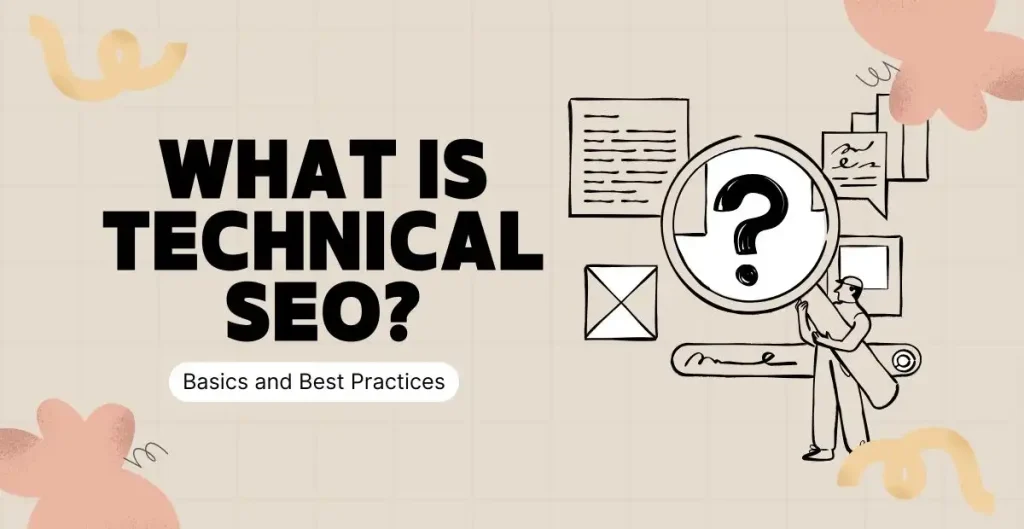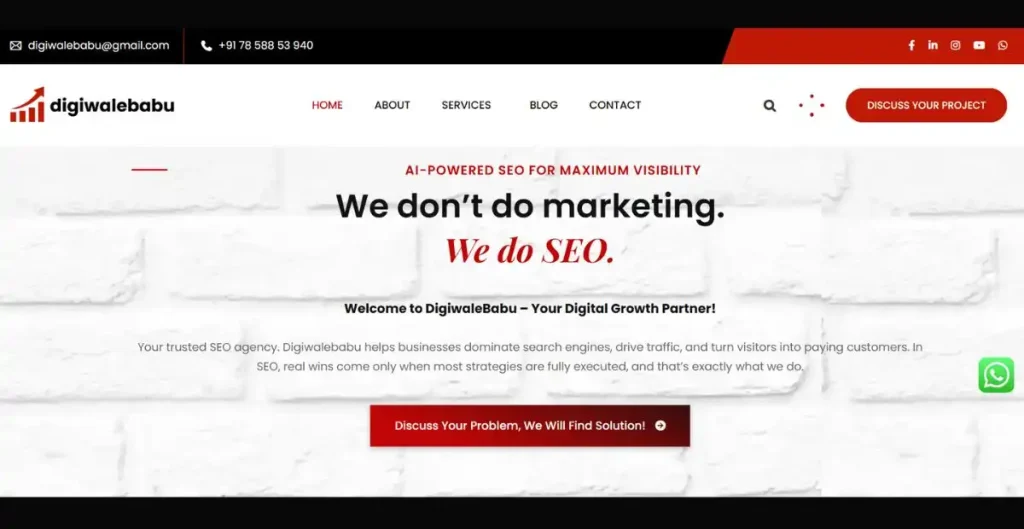
What Is Technical SEO? Basics and Best Practices
Technical SEO forms the backbone of a website’s performance on search engines. While high-quality content and strong backlinks are important, a website without proper technical optimization can struggle to rank effectively. Technical SEO ensures your site is structured, fast, secure, and easily crawlable, giving your content the best chance to reach the right audience.
At Digiwalebabu, an SEO agency in India, we have observed many websites with excellent content fail to gain visibility simply because their technical foundations were weak. This guide will explore the core elements of technical SEO, why it matters, and best practices to enhance your site’s performance and search presence.

What is Technical SEO ?
Technical SEO refers to the optimization of your website’s infrastructure so that search engines can easily crawl, index, and rank your site. It doesn’t focus on content creation or link building; instead, it ensures that your site is technically sound and user-friendly.
Think of it this way: content and backlinks are like the fuel for your website, but technical SEO is the engine. Without a strong engine, the car won’t move—no matter how much fuel you add.
Why Is Technical SEO Important?
Technical SEO is important because it lays the groundwork for your website’s success in search engines. Without it, even the best-written content and strongest backlink strategy may fail to achieve results.
Technical SEO ensures that search engines can crawl, index, and understand your website effectively, while also delivering a smooth experience for users. When your site is fast, mobile-friendly, secure, and well-structured, it naturally performs better in rankings and drives higher engagement.
In other words, technical SEO acts as the foundation of digital marketing, making sure that your content and off-page efforts can shine to their full potential.
Key Reasons Why Technical SEO Is Important:
- Search engines can crawl and index your site: If Google bots can’t access your pages, they won’t appear in search results, no matter how good your content is.
- Improved website performance: A technically optimized site loads faster, is mobile-friendly, and secure, which enhances user experience.
- Higher search visibility: Optimized technical elements like sitemaps, structured data, and HTTPS give you a competitive advantage in SERPs.
- Supports content strategy: Even the highest-quality content needs technical SEO to be discovered and ranked by search engines.
Basics of Technical SEO
To truly master technical SEO, you must first understand its core components. These are the building blocks that ensure your website is easily crawlable, indexable, and user-friendly.
Without them, even the most engaging content won’t achieve its full ranking potential. Let’s break them down step by step:
1. Crawlability
Crawlability refers to how easily search engine bots can explore your website. If crawlers can’t access your pages, they won’t show up in search results, regardless of the quality of your content.
- Use a proper robots.txt file to guide search engine crawlers.
- Avoid blocking important pages that need to rank.
- Maintain a logical and clean site architecture for smooth navigation.
2. Indexability
After crawling your website, search engines must be able to index your content for it to appear in SERPs. Poor indexability means your pages won’t show up even if crawled.
- Ensure important pages are not marked with “noindex” tags.
- Submit an XML sitemap to Google Search Console for better indexing.
3. Website Architecture
A well-structured website architecture benefits both users and search engines. It makes navigation easier and ensures important content is discoverable.
- Use a clear and consistent URL structure.
- Keep important pages within three clicks from the homepage.
- Avoid orphan pages (pages not internally linked anywhere).
4. Mobile Optimization
Since Google now uses mobile-first indexing, your website must perform well on mobile devices. A poor mobile experience directly impacts rankings.
- Ensure your website design is responsive.
- Optimize page loading speed for mobile.
- Avoid intrusive popups or interstitials that block content.
5. Page Speed
Page speed is a critical ranking factor and affects user experience. A slow-loading site often leads to higher bounce rates.
- Compress and optimize images to reduce file size.
- Use a Content Delivery Network (CDN) to serve content faster.
- Minify CSS, JavaScript, and HTML to improve loading time.
6. Secure Sockets Layer (SSL)
Security is a top priority for search engines. Websites with HTTPS are considered more trustworthy and often rank higher than unsecured ones.
- Install an SSL certificate for your website.
- Redirect all HTTP pages to HTTPS to maintain consistency.
7. Structured Data
Structured data, or schema markup, helps search engines better understand your content and display it more effectively in results.
- Use schema.org markup for products, articles, reviews, and FAQs.
- Add structured data to enhance visibility with rich snippets in SERPs.
Best Practices for Technical SEO
To ensure your website ranks well and provides an excellent user experience, implementing technical SEO best practices is crucial. These practices not only help search engines crawl and index your site efficiently but also enhance performance, security, and usability. Let’s look at the most important steps:
- Optimize Robots.txt
Use robots.txt wisely to block unwanted pages, such as admin or backend areas, while allowing essential content to be crawled. Always test your robots.txt file in Google Search Console to avoid blocking important pages. - Create an XML Sitemap
An updated sitemap ensures that search engines can find your important pages quickly. Include only essential URLs, keep it updated, and submit it to Google Search Console or Bing Webmaster Tools. - Improve Site Speed
Faster websites improve both rankings and user satisfaction. Use tools like Google PageSpeed Insights to identify issues, implement browser caching, and optimize images without losing quality. - Ensure Mobile-First Design
Since Google uses mobile-first indexing, your site must be responsive. Test with Google’s Mobile-Friendly Test, use flexible layouts, and optimize buttons/links for mobile users. - Use Canonical Tags Correctly
Prevent duplicate content problems by pointing duplicate or similar pages to a canonical version. This tells search engines which page to prioritize. - Fix Broken Links & Redirects
Regularly check your site for broken links (404 errors). Use 301 redirects for moved pages and avoid redirect chains or loops to maintain smooth navigation. - Implement HTTPS Security
A secure site is a ranking factor and builds user trust. Move your site fully to HTTPS and update all internal links to the secure version. - Add Structured Data Markup
Use JSON-LD schema markup to help search engines understand your content and display rich snippets. Validate with Google’s Rich Results Test. - Optimize Core Web Vitals
Focus on Google’s performance metrics: improve Largest Contentful Paint (LCP), reduce First Input Delay (FID), and minimize Cumulative Layout Shift (CLS). - Monitor Technical Issues
Keep track of crawl errors, indexing issues, and security warnings using Google Search Console. Address issues quickly to maintain site health.
Tools for Technical SEO
Implementing technical SEO becomes much easier when you use the right tools. These tools help you monitor crawl activity, identify errors, track performance, and test structured data to ensure your website is fully optimized. From free Google tools to advanced SEO platforms, here are some of the most useful ones:
- Google Search Console – Essential for monitoring crawl errors, indexing status, and overall site performance in Google search results.
- Screaming Frog – A website crawler that helps detect broken links, duplicate content, missing metadata, and other technical issues.
- Ahrefs / SEMrush – Comprehensive SEO platforms with site audit features to track technical errors, backlink health, and keyword performance.
- GTmetrix & PageSpeed Insights – Useful for analyzing page speed, performance issues, and providing recommendations for faster load times.
- Schema.org Validator – A handy tool to test and validate structured data (schema markup) for rich results in SERPs.
Common Mistakes in Technical SEO
Even experienced SEOs can overlook certain technical details that harm website performance and search visibility. Avoiding these mistakes is just as important as implementing best practices because small errors can prevent search engines from crawling or indexing your site properly. Here are some of the most common pitfalls to watch out for:
- Blocking essential pages in robots.txt – Accidentally restricting important pages can stop them from appearing in search results.
- Forgetting to add canonical tags – Without canonicals, duplicate content may confuse search engines and dilute rankings.
- Having slow-loading pages – Poor site speed frustrates users and negatively impacts SEO performance.
- Ignoring mobile optimization – Since Google uses mobile-first indexing, a non-responsive site can lose rankings.
- Using duplicate meta tags – Repeating the same title and description across pages reduces relevance and CTR.
- Not updating sitemaps after changes – An outdated sitemap may prevent new or updated pages from being indexed.
How Digiwalebabu Can Help

At Digiwalebabu, we specialize in providing end-to-end SEO services in India, with a strong focus on technical SEO. Our experts work to ensure your website is fully optimized for both search engines and users. Here’s how we can help:

- Conduct detailed technical SEO audits – Identify issues that may affect crawlability, indexing, or rankings.
- Optimize site speed, security, and structure – Improve loading times, implement HTTPS, and organize your site for better performance.
- Fix crawl and indexing issues – Ensure search engines can discover and index all important pages.
- Implement structured data – Use schema markup to enhance visibility with rich snippets in search results.
- Ensure mobile and user-friendliness – Make your site fully responsive and easy to navigate on any device.
With our tailored strategies, we make sure your website doesn’t just rank higher but also delivers exceptional user experiences.
People Also Ask About Technical SEO
What is technical SEO in simple words?
Technical SEO refers to optimizing your website’s backend so that search engines can crawl and index it efficiently.
Why is technical SEO important?
It ensures better visibility, faster loading speed, mobile optimization, and improved ranking potential.
What are the basics of technical SEO?
Crawlability, indexability, mobile optimization, speed, HTTPS, and structured data are the key basics.
How do I improve my website’s technical SEO?
Start with an audit, fix broken links, optimize speed, ensure mobile responsiveness, and use structured data.
Is technical SEO different from on-page SEO?
Yes. On-page SEO deals with content, while technical SEO focuses on site infrastructure.
How long does it take to see results from technical SEO?
Usually 2–3 months, depending on the severity of issues fixed.
Do small websites need technical SEO?
Yes, even small sites must be crawlable, mobile-friendly, and secure.
What tools are best for technical SEO?
Google Search Console, Screaming Frog, SEMrush, and GTmetrix are widely used.
Can I do technical SEO myself?
Yes, but it requires technical knowledge. For complex issues, hiring experts is better.
Does Digiwalebabu provide technical SEO services?
Yes, Digiwalebabu offers complete technical SEO audits and implementation services in India.
Final Thoughts
Technical SEO is the foundation of every successful SEO strategy. Without it, even the best content and backlinks won’t bring the desired results. By optimizing crawlability, speed, mobile design, security, and structured data, you create a strong base for long-term success.
If you’re struggling with technical SEO, Digiwalebabu can help you transform your website into a search engine-friendly powerhouse.
